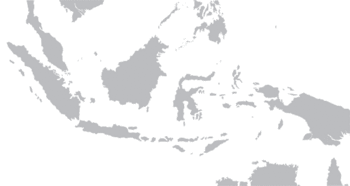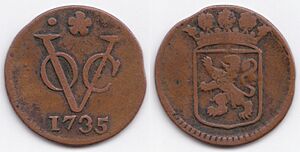Company rule in the Dutch East Indies facts for kids
Quick facts for kids
Dutch East Indies
Nederlandsch-Indië (Dutch)
|
|||||||||
|---|---|---|---|---|---|---|---|---|---|
| 1610–1800 | |||||||||

The territorial evolution of Dutch control in the Malay Archipelago from 1603 to 1800.
|
|||||||||
| Status | Governorates of the Dutch East India Company | ||||||||
| Capital |
|
||||||||
| Common languages | Dutch, Malay, Javanese, Chinese, Indigenous languages | ||||||||
| Government | Colonial government | ||||||||
| Governor-general | |||||||||
|
• 1610–1614
|
Pieter Both | ||||||||
|
• 1796–1801
|
Pieter Gerardus van Overstraten | ||||||||
| Historical era | Early modern | ||||||||
|
• Established
|
1610 | ||||||||
|
• Dissolution and nationalization
|
1800 | ||||||||
|
|||||||||
| 1610–1800 | |

Batavia built in what is now Jakarta, 1682
|
|
| Preceded by | Portuguese colonization |
|---|---|
| Including | First Dutch Expedition to East Indies |
| Followed by | Dutch East Indies |
| Leader(s) | Pieter Both (1610–1614) Pieter Gerardus van Overstraten (1796–1801) |
The time when the Dutch East India Company (called VOC for short) ruled parts of the East Indies began in 1610. This was when the first leader, called a governor-general, was chosen. This period ended in 1800.
By then, the VOC was in serious financial trouble. The company was officially closed down, and its lands became part of the Dutch East Indies. The VOC had gained control over many islands, especially Java.
The first Dutch trading post in Indonesia was set up in Banten in 1603. But the official government of the East Indies started in 1610 with Governor-General Pieter Both. The VOC's main office was first on Ambon Island (1610–1619). Later, Batavia became the capital from 1619 onwards.
Problems like wars, illegal trading, and poor management led to the company going bankrupt. In 1800, the VOC was formally dissolved. Its colonies were then taken over by the Dutch government.
Contents
Why the Dutch Came to the East Indies
A Dutch trip in 1596 was tough, losing many crew members and a ship. But it brought back a lot of spices. The huge profit from these spices made other Dutch groups want to go to Asia too.
The Dutch government saw how much money could be made from the spice trade in the East Indies. To stop different Dutch companies from competing, they combined them into one big company. This was the United East India Company, or VOC.
In 1602, the Dutch government gave the VOC a special right for 21 years. This right meant only the VOC could trade spices in Asia. The company also got special powers, almost like a government. It could start wars, arrest people, make treaties, print its own money, and set up colonies.
First Settlements and Trading Posts
In 1603, the Dutch set up their first permanent trading post in Indonesia. It was in Banten, on the northwest side of Java. In 1611, another post was started at Jayakarta. This place was later renamed 'Batavia' and is now known as 'Jakarta'.
The VOC's main office was on Ambon Island from 1610 to 1619. Ambon was good for spice production. However, it was far from important Asian trade routes. So, the VOC looked for a new main office in the western part of the islands.
The Straits of Malacca were important for trade. But the Portuguese controlled them, making them dangerous. The first Dutch settlement in Banten was also difficult. This was because a strong local ruler controlled the area. There was also competition from Chinese and English traders.
In 1604, the British East India Company also started trading in the Maluku islands. This led to competition between the Dutch and English for spices. A serious conflict happened where some English traders lost their lives. After this, the English mostly left their trading activities in Indonesia.
In 1619, Jan Pieterszoon Coen became the governor-general of the VOC. On May 30, 1619, Coen led 19 ships to attack Jayakarta. He drove out the local forces. From the ruins, he built Batavia, which became the new main office for the VOC.
Expanding Control
Governor-General Coen wanted Batavia to be a major trade center for all of Asia. He hoped to control trade from Japan to China, Burma, and even Sri Lanka. He planned to use local workers to grow the spice trade.
While this big plan didn't fully happen, Coen did create a Dutch monopoly on the spice trade. He made a deal with the Ternate Sultanate in 1607 to control clove production. The VOC also took over the Banda Islands, which gave them control of the nutmeg trade.
In 1641, the Dutch captured Melaka from the Portuguese. This gave them control over the seas in that region. From 1600, the Dutch also fought with the Spanish in the area. Several Dutch fleets attacked the Spanish Philippines. However, they did not take any land there. Peace was made in 1648.
By the mid-1600s, Batavia was a very important trade center. It had successfully defended itself from attacks by the Javanese Mataram kingdom. The Dutch also defeated the city of Makassar in Sulawesi in 1667. This brought its trade under VOC control.
Ports on the island of Sumatra also came under VOC control. The last of the Portuguese were forced out in 1660. The Dutch helped the son of Banten's ruler overthrow his father in 1680. In return, the Dutch got control over the pepper trade and the English were expelled.
The VOC usually focused on its trading posts. It tried not to get involved in expensive wars to take over land. However, the company became deeply involved in the politics of Java. They fought in several wars involving the leaders of Mataram and Banten.
The VOC made an agreement with the king of Mataram, Java's most powerful kingdom. This agreement meant that only Dutch ships could trade within the islands.
The Dutch did not get complete control of all spice trade in Indonesia. But they were much more successful than the Portuguese before them. They used the disagreements between the small kingdoms in Java. This helped them gain a strong foothold in Java. From there, they built a land-based colonial empire. This empire became one of the richest colonies in the world.
People Under VOC Rule
By 1795, the Dutch-controlled areas of the East Indies had over 2 million people. About 1.5 million of these lived on Java's northeastern coast. Later counts suggested this number might have been a bit higher.
If we include other areas like Ceylon (now Sri Lanka), the total number of people under VOC rule grew. It went from about 453,000 in the late 1600s to between 2.4 million and 2.9 million in the late 1700s.
In the late 1600s, most of these people (300,000) lived on Ceylon. By the late 1700s, Ceylon had 350,000 to 817,000 people. But the Dutch had 2 million Javanese people under their rule. The rest lived on other Malay islands. There was also a small group of 25,000 settlers in the Cape Colony (South Africa).
How the VOC Changed Things
The biggest impact the VOC had on local Indonesian kingdoms was their technology. This was especially true for weapons and ships. With this technology, the Dutch were stronger than the local kingdoms. This was very clear in the Moluccas and Java.
Europeans had brought firearms and cannons before, like the Portuguese. But the Dutch VOC used them a lot in their conquests. They also took over some Portuguese ports and colonies in Asia, such as Malacca and Ambon. The VOC got deeply involved in the royal family's issues in Mataram. They used the Javanese rulers' tendency to fight among themselves. This helped the Dutch gain a strong hold in Java.
Another huge impact of the VOC was how it changed trade in the Indonesian islands. The VOC forced a monopoly on the spice trade. This meant they had to get rid of the old trading system. In the old system, many ports, kingdoms, and traders took part. This led to resistance from Asian trading groups. Because of this, the VOC got involved in many battles and conquests.
VOC staff lived separately from the local Indonesians. Dutch people were not seen as high status in the local social systems. So, while the VOC brought new items, methods, and company organization to Indonesia, it didn't change Indonesian thinkers much.
Instead, at a time when Europe was moving away from strict rule and inherited rights, the VOC adopted these ideas from Indonesian societies. Their governors-general acted like royalty. They did not leave the areas they had set up. Like Indonesian royalty, they used local nobles and Chinese agents to organize work.





